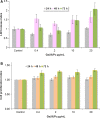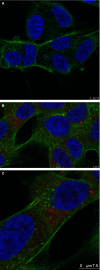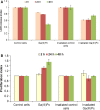Unveiling Ga(III) phthalocyanine-a different photosensitizer in neuroblastoma cellular model
- PMID: 30451363
- PMCID: PMC6349146
- DOI: 10.1111/jcmm.14009
Unveiling Ga(III) phthalocyanine-a different photosensitizer in neuroblastoma cellular model
Abstract
Phthalocyanines (Pc) and their metallated derivatives are strongly considered for photodynamic therapy (PDT) possessing unique properties as possible new photosensitizers (PS). We have used toxicological assessments, real-time monitoring of cellular impedance, and imagistic measurements for assessing the in vitro dark toxicity and PDT efficacy of Ga(III)-Pc in SHSy5Y neuroblastoma cells. We have established the non-toxic concentration range of Ga(III)-Pc, a compound which shows a high intracellular accumulation, with perinuclear distribution in confocal microscopy. By choosing Ga(III)Pc non-toxic dose, we performed in vitro experimental PDT hampering cellular proliferation. Our proposed Ga(III)-Pc could complete a future PS panel for neuroblastoma alternate therapy.
Keywords: gallium(III); neuroblastoma; photodynamic therapy; photosensitizer; proliferation; toxicity; tumour; viability.
© 2018 The Authors. Journal of Cellular and Molecular Medicine published by John Wiley & Sons Ltd and Foundation for Cellular and Molecular Medicine.
Figures







Similar articles
-
Attritional evaluation of lipophilic and hydrophilic metallated phthalocyanines for oncological photodynamic therapy.J Photochem Photobiol B. 2021 Mar;216:112146. doi: 10.1016/j.jphotobiol.2021.112146. Epub 2021 Jan 29. J Photochem Photobiol B. 2021. PMID: 33601256
-
Toxicological and efficacy assessment of post-transition metal (Indium) phthalocyanine for photodynamic therapy in neuroblastoma.Oncotarget. 2016 Oct 25;7(43):69718-69732. doi: 10.18632/oncotarget.11942. Oncotarget. 2016. PMID: 27626486 Free PMC article.
-
Gallium phthalocyanine photosensitizers: carboxylation enhances the cellular uptake and improves the photodynamic therapy of cancers.Anticancer Agents Med Chem. 2012 Jul;12(6):604-10. doi: 10.2174/187152012800617740. Anticancer Agents Med Chem. 2012. PMID: 22263794
-
Tetra-triethyleneoxysulfonyl substituted zinc phthalocyanine for photodynamic cancer therapy.Photodiagnosis Photodyn Ther. 2016 Mar;13:148-157. doi: 10.1016/j.pdpdt.2015.07.001. Epub 2015 Jul 7. Photodiagnosis Photodyn Ther. 2016. PMID: 26162500 Review.
-
Phthalocyanine-Biomolecule Conjugated Photosensitizers for Targeted Photodynamic Therapy and Imaging.Curr Drug Metab. 2015;16(9):816-32. doi: 10.2174/1389200217666151120165404. Curr Drug Metab. 2015. PMID: 26593738 Review.
Cited by
-
In vitro antibacterial activity of photoactivated flavonoid glycosides against Acinetobacter baumannii.AMB Express. 2024 Nov 4;14(1):119. doi: 10.1186/s13568-024-01781-6. AMB Express. 2024. PMID: 39495421 Free PMC article.
-
Carboranes as unique pharmacophores in antitumor medicinal chemistry.Mol Ther Oncolytics. 2022 Jan 10;24:400-416. doi: 10.1016/j.omto.2022.01.005. eCollection 2022 Mar 17. Mol Ther Oncolytics. 2022. PMID: 35141397 Free PMC article. Review.
References
-
- Dongen GAMSV, Visser GWM, Vrouenraets MB. Photosensitizer‐antibody conjugates for detection and therapy of cancer. Adv Drug Deliv Rev. 2004;56:31‐52. - PubMed
-
- Moan J, Peng Q. An outline of the hundred‐year history of PDT. Anticancer Res. 2003;23(5A):3591‐3600. - PubMed
-
- Maduray K, Odhav B. The in vitro photodynamic effect of laser activated gallium, indium and iron phthalocyanine chlorides on human lung adenocarcinoma cells. J Photochem Photobiol, B. 2013;128:58‐63. - PubMed
Publication types
MeSH terms
Substances
LinkOut - more resources
Full Text Sources
Medical

